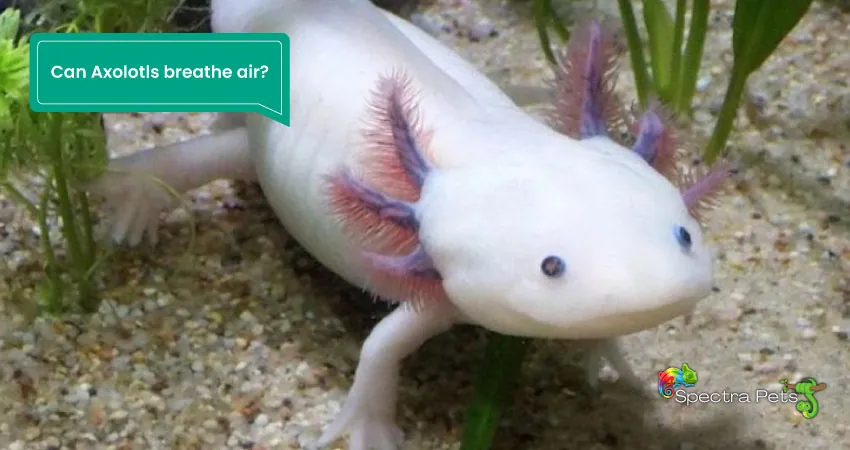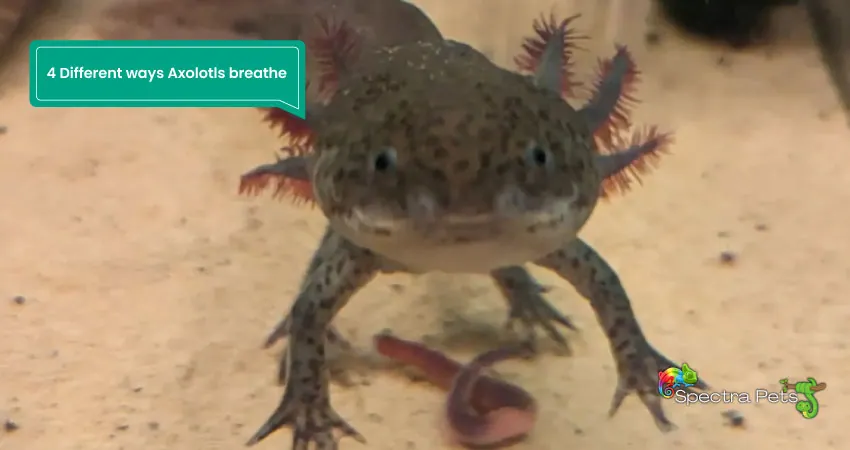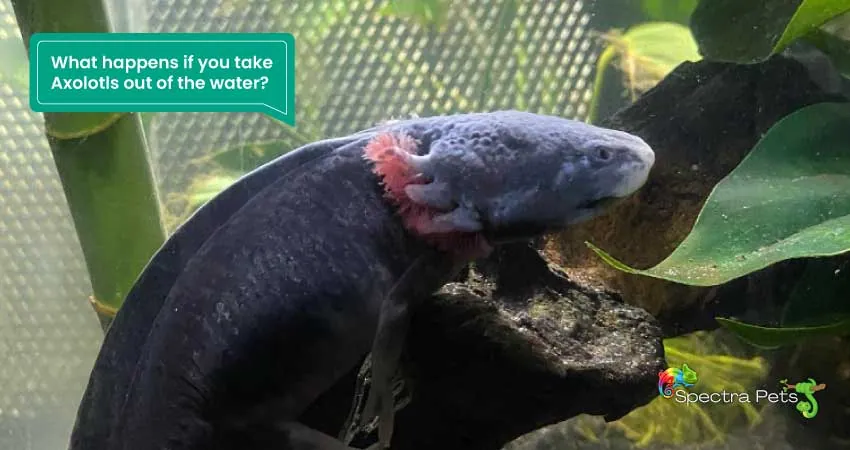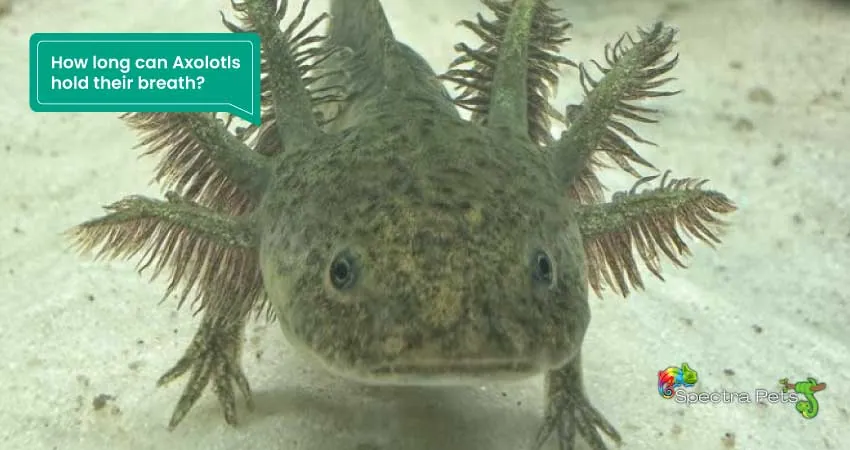The axolotl is a unique aquatic species that can breathe both air and water. However, it’s important to note that its underdeveloped lungs are not able to support it for extended periods on land. Despite its leg-like appearance, extended time outside of water can be fatal to the axolotl.
To avoid accidentally harming your pet, it’s crucial to have a comprehensive understanding of the axolotl’s breathing process. With four different modes of breathing – skin breathing, lung breathing, buccal respiration, and gill breathing – the axolotl is truly a remarkable creature.
This guide will provide a detailed overview of how the axolotl breathes air. Keep reading to learn more!

Can Axolotls breathe air?
Compared to other amphibian species, the Mexican salamander doesn’t go through any notable changes in its breathing system so its gills, skins, or underdeveloped lunges give all the backup for breathing air.
However, if you ever see any axolotl swimming on the water’s surface to take a bit of air, that indicates the water may have less amount of dissolved oxygen. But if you encounter them doing them a few times a day, then it’s okay.
4 Different ways Axolotls breathe
No exception to other creatures, this aquatic animal’s lifeline is oxygen. This critter is blessed with 4 different ways to absorb oxygen in its body.
Let’s see them one by one…
1. Breathing through skin
The skin of the Axolotls is extremely soft, moist, and thin, and it works as one of the passages to carry oxygen into their little body. So, the skin breathing process of an Axolotl is a very fast & efficient one.
Moreover, this breathing is also known as the cutaneous respiration system. In this whole mechanism, the function of the gills and lungs is not directly involved.
They simply absorb the oxygen through the skin, and it gets diffused in their bloodstream within a fraction of a second. And the carbon dioxide is also expelled using the moist skin into the water.
Don’t forget that the key element of this breathing process is the slimy coating on the axolotl’s skin.

2. Breathing using the gills
Though the feathery gills seem like they’re one of the core beauty of these magnificent creatures, they also work as a breathing system. It’s a common scenario to see the wiggling of the feathery gills of your axolotls.
Every time you see them wiggling their feathery gills means that they are breathing peacefully. The main attribute of these gills is that they can become enlarged on the surface so that they can exchange a big amount of gas within a short time.
During the breathing process, oxygenated water gets into the membrane, and this membrane filters out the oxygen and lets it move to the bloodstream directly. The same thing happens for the carbon dioxide as it gets released by these membranes into the water.
Moreover, the feathery gills of the axolotl are blessed with rakes that ensure that any parasites or impure elements are cleared out before oxygen enters the bloodstream.
3. Buccal respiration
This breathing procedure is almost similar to the skin breathing system of an axolotl. The buccopharyngeal membrane is located right behind the throat of your cute axolotl.
When they want to take oxygen, they can open up the skin on top of the buccal membrane and intake oxygen as per their requirement. Through these membranes, oxygen directly goes to their bloodstream. Right after breading is complete, it will close the buccal.
4. Breathing through lung
Rudimentary lungs are the last option for the breathing of an axolotl. Because, in this process, they can intake the lowest amount of oxygen compared to the other 3 methods I talked about earlier.
This intelligent & gorgeous amphibian will use its lungs when the oxygen level is very low in the water.
However, they can breathe using their lungs when they are in a bit of a playful & happy mood. They sometimes take small breaths and use them like airbags to float into the water tank.
And, the shape of the lungs is like a sac thing that has folded pockets. These folded pockets were surrounded by blood vessels. There is a thin membrane on the sac which helps the oxygen to reach into the bloodstream through capillaries which eventually reach the heart of the axolotl to function properly.
What happens if you take Axolotls out of the water?
The most important thing to remember is that as long as the axolotl’s body remains moist and cool, it will remain healthy. If you plan to keep them out of the water, your pet will start losing its breathing ability.

In the following part, you will see what can happen to axolotl when it’s out of the water…
Dysfunctional organs & limbs
The decision to keep the axolotl out of water is a red signal for your little buddy as they can end up having a loss of both organs and limbs. Axolotls are unique amphibians that have no such thing as metamorphosis in their entire life.
So, their limbs are not built to take their body weight which is nothing for their other salamander brothers in the wild or captivity. When you see these creatures walking inside water tanks or canals, they walk with the help of the natural buoyancy of water waves.
Thus, they don’t feel the weight while walking inside the water tank. However, on dry land, it’s the opposite scenario where the water buoyancy advantage is missing.
As a result, they will feel the body weight with every step on land and the legs will not be able to carry the body weight and will become dysfunctional and collapse.
The more time you can keep them and the more the axolotl tries to walk it will badly lead to damage & loss of their skin layers. And the most dangerous part is that a forceful walking period will also damage their internal organs to crush & fail.
The slimy coat dries out, leading to loss of breath
If you look at the axolotl’s body, you will notice the slime coat which needs to moisten all the time. And when it becomes dry, they become extremely vulnerable because this works as a shield for their extremely sensitive skin.
Adding to that, this slimy coat protects them from varieties of infections, viruses, and bacteria. With the loss of functionality of this skin, they become fully defenseless from unseen predators. So their bodies will become a breeding ground for various diseases.
Sadly, the dehydration process will finally end up as multiple organ failure. With the loss of moisture of the slime coating, the axolotl will find it very hard to breathe using their gills. And the undeveloped lunges won’t provide support for a long time.
Another major problem with dry skin is these aquatic buddies won’t be able to receive any oxygen to perform breathing through their skin. So it would turn out deadly if you keep it like that out of water.
High-level stress
It’s natural & normal for every species to fall under heavy stress when they are pushed out of their comfortable climate. In the case of axolotls, this can be so hard that they can become physically weak & fragile.
As soon as they are out of the water, they will lose their appetite instantly. And, you can also detect the uneasiness by looking at their movement. This poor aquatic life can form different types of diseases which can start as a result of immense stress on their body.
How long can Axolotls hold their breath?
When it comes to holding breath, most of the axolotls can’t hold their breath for more than a few hours while some axolotls are a pure miracle because those species can hold their breath for up to 1 year.
Please remember that the long duration of holding breath also depends on the level of oxygen in their water tank. The long holding breath is only possible when the oxygen level is at a peak appropriate level.
Moreover, the breathing process is extremely incomparable to the breathing of many terrestrial animals. They will keep doing the gas exchange process through their gills and skin.

Whenever they are not breathing through their lungs, oxygen can still get inside their body and reach the bloodstream and, they can keep going on.
So if you are wondering if axolotls can breathe air out of the water, then the answer is when you remove them from the water tank or water body, the level of oxygen in the axolotl’s bloodstream goes down and the carbon dioxide level goes higher.
Which eventually leads to toxic forming within the body. As a result, one organ after another collapses and faces death.
Frequently asked questions (FAQ)
Can axolotl breathe out of water?
Yes, an axolotl can breathe out of the water using its skin, but that’s for a very short period. Because the skin will turn dry, and they won’t be able to breathe through the skin properly.
How long can axolotl survive out of water?
Depending on the species, it can vary. Some axolotl can survive much less than one hour while others can survive a bit close to one hour.
However, when they are outside of water, they will have a hard time breathing, so their body will slowly shut down due to lack of oxygen.
Do axolotls prefer water or land?
Axolotls highly prefer water for living, and they don’t keep the land as the last option. It’s their body mechanism that is not suitable at all for living on land.
How do Axolotls breathe?
Axolotl can breathe in 4 different ways which include skin breathing, rudimentary lung breathing, buccal respiration, and gill breathing.
Can the axolotl breathe through the skin?
Yes, the axolotl can swiftly breathe through their skin as their skin has a slimy coat which helps a lot to get the oxygen to dissolve into their bloodstream.
Final words
You saw how an axolotl can breathe in different ways. These beautiful creatures are indeed a full-time aquatic species that cannot survive a long time out of water.
Though they have lungs, gills, and skin breathing systems, nothing can help them if it’s not inside the water aquarium.
Now you know that axolotls can breathe air, but they need their preferred condition to breathe properly. Hopefully, you will have a better caring hand after going through this short blog post.
Related Articles:

